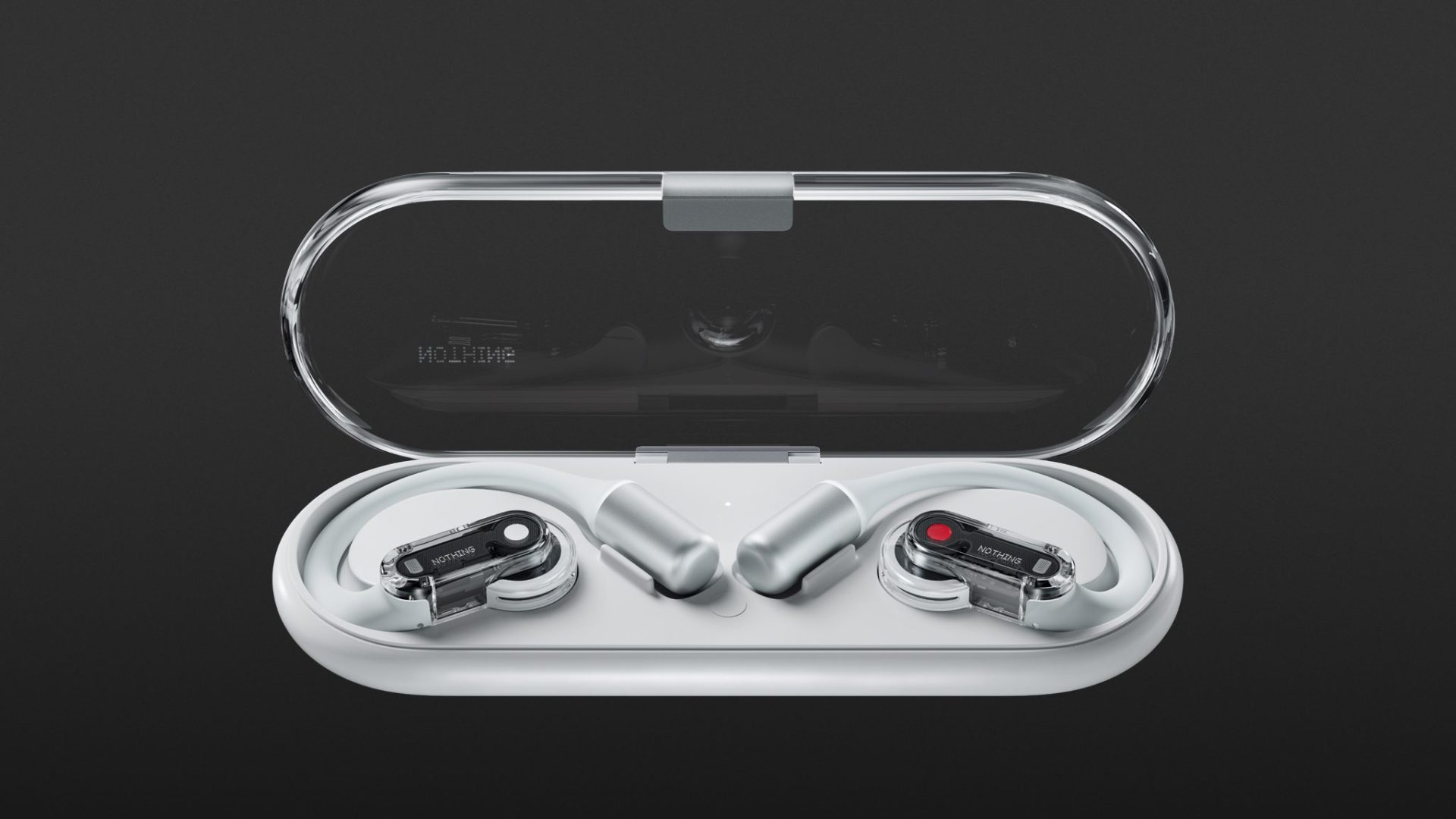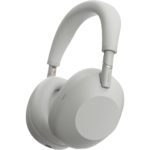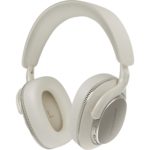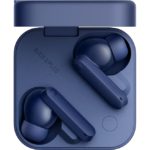The Nothing Ear (open) are high quality headphones in the new trendy open ear category. They deliver great sound and are comfortable to wear.
- High wearing comfort
- Sound (at moderate volume)
- Multipoint
- EQ from the Nothing X app
- Design
- No manual on/off
- No automatic pause function
- Difficulty suppressing wind noise
London-based technology company Nothing has done it: Open ears now complement their existing true wireless in-ear portfolio.
Table of contents
- Open ears: who are they for?
- Scope of delivery: What’s included in the package
- Design and comfort: Light and comfortable for everyday use
- Operation: How to use the controls
- Bluetooth connection: features and stability
- Nothing X App: highlights and standards
- Battery life: how long do the Nothing Ear (open) last?
- Sound quality: how do the Nothing Ear (open) sound?
- Making phone calls: voice quality and noise cancellation
- Conclusion: is the Nothing Ear (open) worth buying?
Open Ear: Who are they for?
Open-ear models are particularly popular with athletes. That’s because they’re designed so that the speaker sits in front of the ear canal, allowing you to hear music and the world around you at the same time. But the design comes at the expense of sound quality.
So does the Ear (open) have the same weaknesses as other open earphones? Or has Nothing done everything right here? We’re here to help you find out.
Scope of delivery
The Nothing Ear (open) come in a white pill-shaped carrying case with a clear top and rounded, smooth edges. Fans of the Nothing style will be in their element, as will fidget spinners, who will be able to indulge their passion thanks to the indentation on the lid of the case. A very short USB-C charging cable is also included. The build quality leaves nothing to be desired.
The headphones themselves sit firmly in the case thanks to strong magnets, but they do rattle a little when shaken because the silver battery packs at the ends hit small plastic bumps inside.
The IP54 rating of the headphones and case means that they are protected from dust, dirt, splashing water and sweat.
The Nothing Ear (open) is this comfortable
You have to hand it to the company – their version of open-ear headphones managed to do something the competition had yet to do: the tester simply forgot they were on his ears. Weighing in at just over 8 grams each, and with thin, slightly twisted ear hooks, the Nothing Ear (open) sit behind the ears without any noticeable pressure. According to the manufacturer, the white silicone coating is skin-friendly, and as a wearer of glasses I had no problems with the ‘double cast’ behind my ears. Thick temples can be more bulky than my finely crafted model, so a trial fit is definitely recommended.
The Ear (open) is easy to use
The Nothing Ear (open) are controlled by physical controls – small indentations on the top of the speakers. It takes a bit of practice and strength to find them.
The commands can be customised via the Nothing app. As the headphones have no ANC, transparency mode or other special features, these cover the basics such as play, pause, call management and access to the voice assistant.
If you have a Nothing and/or CMF smartphone, you can look forward to an extra feature: pressing the button doesn’t call up the voice assistant, but rather ChatGPT, and you can ask for information without having to type. Unfortunately, this didn’t work at all in our test. Although the official ChatGPT app was installed on a Nothing phone (2a) and the voice function was already in use, the Google Assistant always answered.
How do I pair the Nothing Ear (open)?
The Nothing Ear (open) supports Bluetooth version 5.3 and the Bluetooth codecs SBC and AAC. It also supports Google Fast Pair and Microsoft Swift Pair. Thanks to Multipoint, you can connect the earphones to two different devices and seamlessly switch between them. You can also use a single earpiece.
The Bluetooth connection is stable over short distances, but we noticed during testing that when the player was about seven metres away and you held your left hand in front of the left earpiece, the data stream was shielded and interrupted.
Do I need to install the Nothing X app for the Nothing Ear (open)?
No, if you don’t like apps, you don’t have to, but I still recommend using the app. It’s the only way to get the most out of the Nothing Ear (open). The equaliser in particular is a real highlight!
Of course, if you want to keep it simple, you can use the simple EQ mode and choose whether you want more bass or more treble. But the Custom EQ mode goes one step further, allowing you to select and move each frequency, and even adjust the bandwidth of each of the eight bands. Want to make just the vocals stand out by boosting a narrow band? That’s no problem with the Nothing X app.
Of course, the app has even more to offer: key remapping, a low-latency gaming mode, multipoint, an earphone finder and firmware updates.
How long does the Nothing Ear (open) battery last?
The Nothing Ear (open) lasts for approximately 8 hours on a single charge, and 30 hours in total with the battery charger. For those who spend a lot of time on the phone, this is reduced to 6 hours on a single charge and 24 hours in total with the charging case.
Nothing Ear (open) sound quality
The Nothing Ear (open) are not designed for either critical or audiophile listening, thanks to their open design, which places the drivers in front of the ear canal rather than directly in it.
As with many open-back earphones, the focus is clearly on the mid-range frequencies. The Nothing Ear (open) delivers a solid performance here, with clear presence and a pleasing attention to detail. In particular, vocals and instruments in the mid-range are reproduced cleanly and accurately.
The low frequencies, however, are surprising for an open design. The bass is more punchy than expected and gives many tracks a pleasant richness. The sub-bass is not as deep as you might expect from closed systems or in-ear monitors, but for an open design, the bass is perfectly acceptable.
The treble is also clear and detailed. It gives the music a fresh sparkle without being harsh. Depending on your listening environment and preferences, you can adjust the treble using the built-in equaliser to reduce distracting frequency peaks or to emphasise individual elements in the soundstage.
Important to know: The sound quality of the Nothing Ear (open) is highly dependent on the environment and volume. In quiet environments, you can hear details and enjoy the wide soundstage. In noisy environments, you will experience a loss of sound quality because the open earphones do not block out ambient noise. This shows that they have been designed for listeners who need to be aware of their surroundings, whether they are exercising or working.
The increase in presence at higher frequencies is clearly audible when the volume is turned up. This is something open ears will have to live with (for now). At higher volumes, the treble not only sounds more powerful, it also tends to emphasise sibilants.
How well can I make phone calls with the Nothing Ear (open)?
The Nothing Ear (open) does a good job of blocking out background noise in office and street environments, but has difficulty blocking out wind noise. The sound quality was not the best in our tests either, but we were always able to understand each other.
What are the benefits of open-ear headphones?
Unlike normal headphones, open-ear headphones leave the ear canal free for ambient noise.
The bottom line
If you are aware of the pros and cons of open-ear headphones, then the Nothing Ear (open) should be one your first choices. The workmanship is impeccable and the well thought-out design makes them extremely comfortable to wear, even after hours of use. At moderate volumes, they sound natural, rich in detail and even in the bass range. Together with the great equaliser, you get a coherent package that promises natural listening.
Technical specifications
- Ear couplingOpen-ear
- Typeopen
- Transducer principledynamic
- Weight without cable8.1 g each, case 62.4 g
What's in the box
- USB-C charging cable
- Charging case
Special features
- BT codecs: SBC, AAC
- BT version: 5.3














































